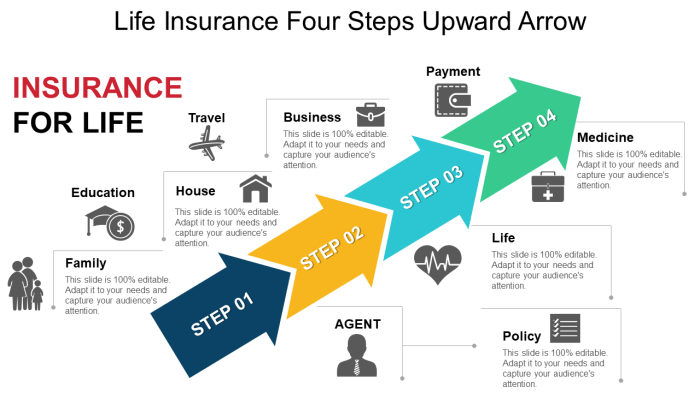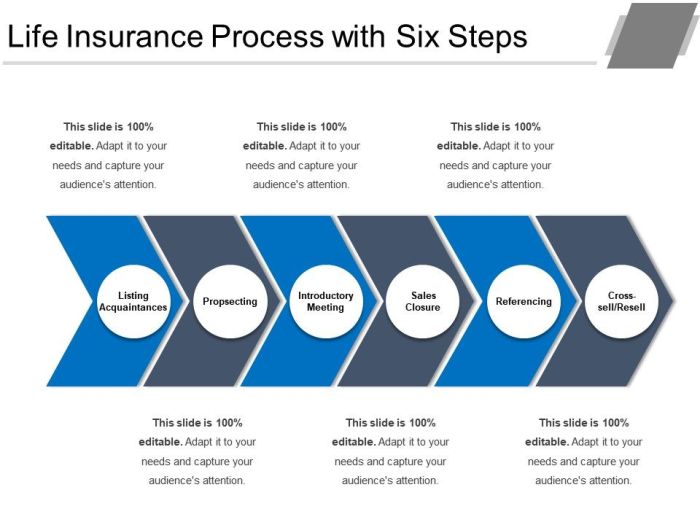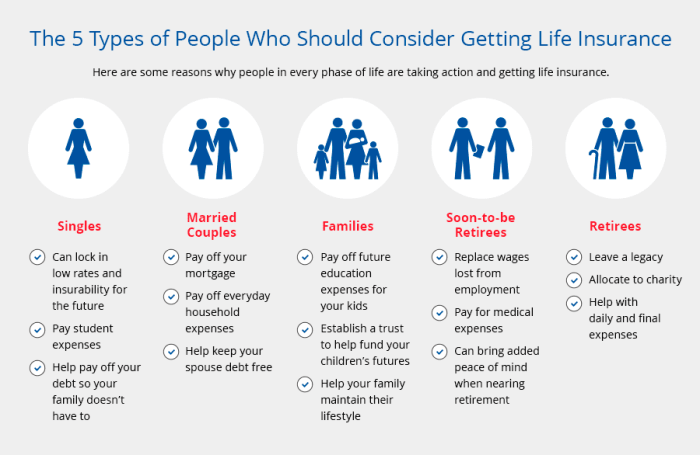
Steps to get life insurance – Navigating the world of life insurance can be daunting, but it’s crucial for safeguarding your loved ones’ financial future. Our comprehensive guide will empower you with the knowledge to make informed decisions, ensuring you secure the right coverage to protect your family.
From assessing your needs to understanding the application process, we’ll guide you through every step to ensure you have a solid understanding of life insurance and its significance.
Determine Your Coverage Needs

Life insurance provides financial protection for your loved ones in the event of your untimely demise. To ensure adequate coverage, it’s crucial to assess your personal circumstances and financial obligations.
Factors to Consider
* Income and expenses:Determine your monthly income and essential expenses, including housing, food, transportation, and healthcare.
Debts and obligations
Calculate your outstanding debts, such as mortgages, student loans, and credit card balances.
Family and dependents
Consider the number of people who rely on your income and their financial needs.
Future financial goals
Factor in anticipated expenses, such as education, retirement, and major purchases.
Research Different Types of Policies
When choosing a life insurance policy, it’s essential to understand the different types available. Each policy offers unique features and benefits, so it’s crucial to determine which one aligns best with your financial goals and needs.
Term Life Insurance
Term life insurance provides coverage for a specific period, typically ranging from 10 to 30 years. It offers affordable premiums compared to other policies and is suitable for individuals seeking temporary protection, such as paying off a mortgage or covering education expenses for children.
Whole Life Insurance
Whole life insurance provides lifelong coverage and includes a cash value component that grows over time. The premiums are generally higher than term life insurance, but the policyholder can borrow against the cash value or withdraw it for various financial needs.
Universal Life Insurance
Universal life insurance combines elements of term and whole life insurance. It offers flexible premiums and death benefits that can be adjusted over time. The cash value component also grows on a tax-deferred basis, providing potential for financial accumulation.
Compare Quotes from Multiple Insurers

To secure the most favorable insurance plan, it’s crucial to compare quotes from multiple insurers. By doing so, you gain insights into the competitive landscape and identify policies that align with your specific needs and budget.
Various factors can influence premium costs, including age, health, and lifestyle. Insurers assess these aspects to determine the level of risk associated with insuring you. For instance, younger individuals typically pay lower premiums due to a lower likelihood of health complications.
Similarly, those in excellent health may qualify for discounts compared to those with pre-existing conditions.
Factors Affecting Premium Costs
- Age
- Health
- Lifestyle (e.g., smoking, alcohol consumption, high-risk activities)
- Occupation
- Hobbies and recreational activities
- Family history of certain medical conditions
Understand the Application Process

Applying for life insurance is a crucial step in securing financial protection for your loved ones. The application process typically involves several steps and requires specific documentation and information. Understanding these steps and requirements can help you navigate the process smoothly and efficiently.
Steps Involved in Applying for Life Insurance
- Gather Information:Before applying, gather necessary information such as your personal details, health history, and financial status.
- Choose an Insurance Provider:Research and compare different insurance providers to find the one that best suits your needs and offers competitive rates.
- Complete the Application:The application form typically includes questions about your age, health, lifestyle, and financial situation.
- Medical Exam:Depending on the coverage amount and policy type, you may need to undergo a medical exam to assess your health.
- Review and Decision:The insurance provider will review your application and medical records to determine your eligibility and coverage details.
Required Documentation and Information
| Document | Information |
|---|---|
| Birth Certificate | Proof of age and identity |
| Medical Records | Health history, including any pre-existing conditions |
| Financial Statements | Income, assets, and liabilities |
| Beneficiary Information | Names and contact details of designated beneficiaries |
Medical Examination and Underwriting: Steps To Get Life Insurance

Medical examinations and underwriting are crucial steps in the life insurance application process. They provide insurers with essential information to assess an applicant’s health and determine their risk classification.
During a medical examination, a healthcare professional will perform various tests, including a physical exam, blood and urine tests, and possibly an electrocardiogram (ECG) or other specialized tests. These tests help the insurer evaluate the applicant’s overall health, identify any existing or potential health conditions, and assess their lifestyle habits, such as smoking or excessive alcohol consumption.
Underwriting Process
The underwriting process involves analyzing the information gathered from the medical examination, as well as other factors such as the applicant’s occupation, hobbies, and family medical history. Based on this assessment, the insurer determines the applicant’s risk classification, which influences the premium amount and coverage terms offered.
- Preferred Risk:Individuals with excellent health, no significant health conditions, and a healthy lifestyle may qualify for the lowest premiums.
- Standard Risk:Applicants with minor health conditions or lifestyle habits that increase their risk slightly may receive standard premiums.
- Substandard Risk:Individuals with significant health conditions or high-risk behaviors may be classified as substandard risks and face higher premiums or coverage restrictions.
- Declined Risk:In rare cases, applicants with severe health conditions or extremely high-risk lifestyles may be declined coverage.
Policy Issuance and Premiums
Once your application is approved, the insurance company will issue a policy. The policy will Artikel the terms of your coverage, including the amount of coverage, the length of the policy, and the premium you will pay.
Premiums are the payments you make to keep your policy in force. You can choose to pay your premiums monthly, quarterly, semi-annually, or annually. Some insurance companies offer discounts for paying your premiums in advance.
Payment Methods
There are several different ways to pay your premiums. You can pay by check, credit card, or electronic funds transfer. Some insurance companies also offer the option to pay your premiums online.
Maintaining Your Policy

Maintaining a life insurance policy in good standing is crucial to ensure its effectiveness and avoid any lapses or cancellations. Here are some tips to help you keep your policy active:
Regularly review your policy and coverage limits to ensure they still meet your needs. As your life circumstances change, so may your insurance requirements. Adjust your policy accordingly to provide adequate protection for your loved ones.
Premium Payments, Steps to get life insurance
- Make timely premium payments to avoid policy lapse. Late payments can lead to penalties or cancellation.
- Set up automatic payments to ensure premiums are paid on time, even if you forget or encounter financial difficulties.
- Consider increasing your coverage if your financial situation improves or your family grows.
Policy Changes
- Inform your insurer of any significant life changes, such as marriage, divorce, or a new child. These events may impact your coverage needs.
- Review your policy annually with your insurance agent to discuss any changes or updates.
Consequences of Policy Lapse
If you fail to pay premiums on time, your policy may lapse. This means the policy will no longer be in effect, and your beneficiaries will not receive the death benefit. Reinstating a lapsed policy may require a medical exam and additional fees.
Non-payment of premiums can also impact your credit score and make it more difficult to obtain insurance in the future.
Beneficiary Selection and Changes
Beneficiaries are the individuals or entities who receive the life insurance proceeds upon the policyholder’s death. Selecting the right beneficiaries is crucial to ensure that the proceeds are distributed according to your wishes. Legally, beneficiaries have certain rights and responsibilities, and it’s essential to understand the implications of your choices.
Process for Changing Beneficiaries
Life circumstances can change, and so can your beneficiary selections. Changing beneficiaries is generally a straightforward process, but it requires specific documentation and adherence to the policy’s terms. Contact your insurance provider to request a beneficiary change form. Complete the form with the updated beneficiary information and submit it along with any required supporting documents, such as a copy of the beneficiary’s ID or a marriage certificate.
The insurance company will process the request and update the policy accordingly.
Ultimate Conclusion

Securing life insurance is not just a financial decision; it’s an act of love and responsibility. By following these steps, you can ensure that your loved ones are protected against life’s uncertainties and have the financial means to fulfill their dreams.
FAQ Insights
What factors should I consider when determining my coverage needs?
Consider your income, debts, dependents, and future financial goals.
What are the different types of life insurance policies available?
Term life, whole life, and universal life policies offer varying coverage options and premiums.
Why is it important to compare quotes from multiple insurers?
Comparing quotes ensures you get the best coverage at the most competitive price.
What documents are typically required for a life insurance application?
Proof of identity, income, and health are commonly required.

